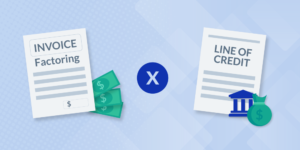
Contractors and suppliers know all about the cash flow challenges in the construction industry. With payments often taking almost 90 days, contractors and suppliers need alternatives to keep the cash flowing in their businesses. Two options — invoice factoring and lines of credit —can be used to help fund everyday business expenses, expansions, or job startups.
Let’s look at these two financing options and their differences, so you can select the best one for your company.
What is invoice factoring?
Invoice factoring involves borrowing against your receivables. You get cash upfront and sell your invoices to a factoring company. Typically, the factoring company pays you 70–80% of the invoice value right away. Once you get the cash, however, the factoring company owns the invoice.
Your customer then pays the factoring company the face value of the invoice. The factoring company pays you the balance of the invoice less their fee, which is typically 1–3% of the invoice value.
But invoice factoring isn’t cheap, and that cost can fluctuate depending on the size of your business. Factoring is generally more expensive than a bank loan and includes fees for the factoring itself, administrative expenses, and wiring.
Factoring is one way to get some cash fast if you have open accounts receivable that you know will be paid within terms — it is not a way to collect on late payments. Factoring companies investigate your customers and will only accept those that pay on time. Depending on your business situation, the drawbacks to factoring will often outweigh the benefits.
What is a line of credit?
For construction companies, there are two sources of lines of credit: banks and vendors.
A line of credit from the bank is a loan that you take out only as you need it. It involves a credit history and financial statement review by the bank to determine if your company is a good credit risk. If the line is granted, you continue to write checks on your account, and bank funds are transferred to cover them once you are overdrawn. Each month, you pay the balance you borrowed plus interest expense.
Vendors can also extend a line of credit. This is called trade credit. The vendor will review your credit application and possibly financial statements, then decide how much credit to extend. Then, you purchase materials without paying upfront cash. The credit delays payment for a certain number of days, depending on the terms of the agreement. Then payment becomes due along with interest on late payments.
Differences between factoring and a line of credit
Qualifications needed
The factoring company looks at the qualifications of the invoice and your customer. They may request financial information on your customer to determine if they are a good credit risk before purchasing an invoice.
A line of credit is based on reviewing your company’s financial statements and credit history. The bank or vendor may choose to extend credit based on your creditworthiness.
Ease of setup
As long as the invoice and/or your customer qualifies financially for invoice factoring, it’s fairly easy to set up. It’s easier if you have a relationship with the factoring company already established.
To get a line of credit you must go through a financial review by the bank or supplier. This may take days or weeks. Setting up a trade credit account is easier than getting a line of credit at a bank, which requires lots of documents to be signed.
Communicating with your customer
The factoring company will typically take over all communication with your customer regarding payment once you sell the invoice to them. Payments go to the factoring company and any collection problems are the factoring company’s responsibility. With a line of credit, your customer isn’t involved in the financing at all.
Cash availability
With factoring, you don’t get paid until you’ve invoiced your customer, which means some work has been completed. Factoring doesn’t help with project startup expenses because you haven’t invoiced any work. So, you’ll need cash from another source until you can send your first invoice. Once a line of credit has been set up, it can be used at any time.
Cost
Suppliers often offer free credit to get your business and keep material moving in their inventory. Banks will charge interest on the amount of money you use, with the rate dependent on your creditworthiness. Factoring is not regulated, so there’s no telling what fees you may be charged. Read your factoring agreement carefully so there’s no surprises.
Credit limit
With a line of credit, either from a bank or supplier, the amount of credit you receive is based on your credit history and financial statements. In factoring, the limit is based on the amount of your accounts receivable.
Factoring line of credit
Another option for contractors may be a factoring line of credit. It is a line of credit, similar to a bank’s, that is based on the amount of receivables you have on your books.
As that amount goes up or down, so does the amount of credit you have available. This type of credit is easily confused with both factoring and lines of credit.
Financial alternatives for contractors
There are a growing number of alternatives for contractors to get the cash they need to purchase materials, get a new job off the ground, or expand their business. Whether it’s invoice factoring, material financing, a line of credit, a trade credit account, or a traditional bank loan, contractors have more options than ever to keep their businesses running and growing.